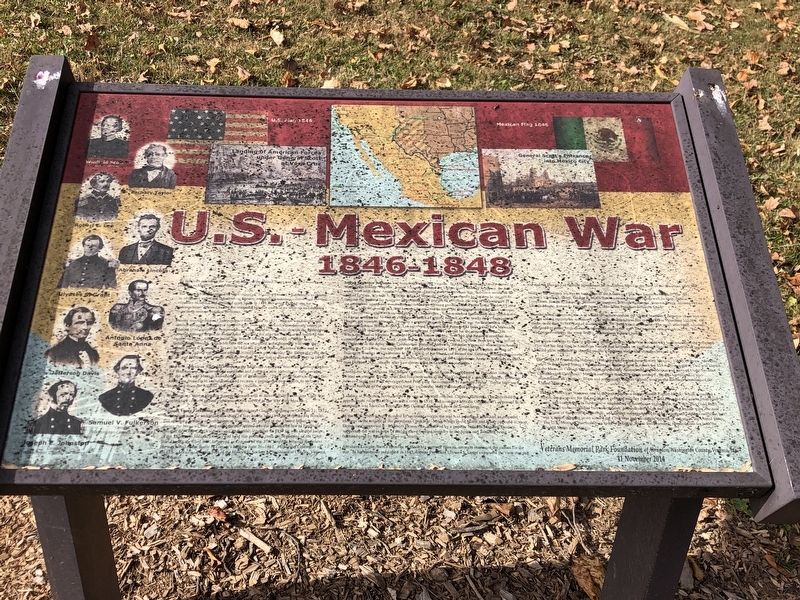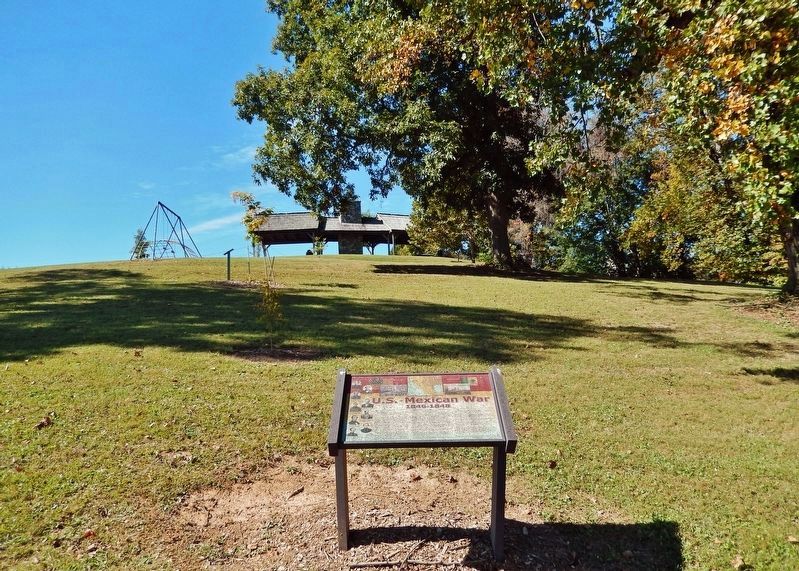Abingdon in Washington County, Virginia — The American South (Mid-Atlantic)
U.S.-Mexican War
The United States, inspired by the concept of “Manifest Destiny,” confidently expanded its territories westward. Meanwhile, Mexico struggled to maintain control over the vast expanses of land it had obtained from Spain in 1821 following its long war for independence. Mexico lacked the resources to settle much of its territory and suffered from deep internal political divisions.
Having recently attained independence from Spain in 1821, Mexico was fraught with internal struggles that verged on civil war. However, Mexico was relatively united in refusing to recognize the independence of the Republic of Texas, despite the agreement General Antonio Lopez de Santa Anna lobbied for after his defeat at the battle of San Jacinto in 1836. After the battle, the Texans formed the Republic of Texas as an independent country, which Mexico did not recognize and threatened war with the United States if it annexed Texas. In 1845 the United States did annex Texas and it became the twenty-eighth state of the United States of America. The following year the U.S. and Mexico were at war with each other, a war that continued from 1846 to 1848.
The U.S.-Mexican War, also known as the Mexican-American War, was a defining event for both nations, transforming a continent and forming a new identity for their peoples. By the war's end Mexico lost nearly half of its territory. The United States acquired the southwest from Texas to California and became a continental power with its territory extending from the Atlantic to the Pacific Oceans.
Washington County, Virginia was represented well in this conflict: Two future Civil War Confederate officers gained experience from serving in the War with Mexico.
Samuel Vance Fulkerson was born in Washington County, Virginia on October 21, 1822. As a young man he undertook the study of law, and in late 1846 he obtained his license and opened a practice in southwestern Virginia. He served in the United States Army during the Mexican War and subsequently returned to the practice of law in Estillville (present day Gate City, Virginia) and Abingdon, Virginia. In 1857 he was elected judge of the Thirteenth Judicial District and held this post until the beginning of the Civil War. During the Civil War, he served as Colonel of the 37th Virginia Infantry Regiment. He was killed the Battle of Gaines's Mill on June 26, 1862. Fulkerson's memoirs of the U.S.-Mexican War are part of the Historical Society of Washington County, Virginia collection.
Joseph Eggleston Johnston was born near Farmville, Virginia. In 1811, the Johnston family moved to Washington County, Virginia. Joseph Johnston attended the United States Military Academy, the first cadet from west of the Appalachian Mountains. During the U.S.-Mexican War, Johnston served on the staff of Lt. Gen. Winfield Scott in the Siege of Veracruz, having been chosen by Scott to be the officer carrying the demand for surrender beforehand to the provincial governor. He was in the vanguard of the movement inland and was severely wounded performing reconnaissance prior to the Battle of Cerro Gordo. After recovering in a field hospital, he returned to duty. He distinguished himself at Contreras and Churubusco, and was wounded again at Chapultepec. Scott remarked humorously that “Johnston is a great soldier but he had an unfortunate knack of getting himself shot in nearly every engagement.” Despite his wounds, however, Johnston's greatest anguish during the war was the death of his nephew, Preston Johnston. When Robert E. Lee informed Johnston that Preston had been killed by a Mexican artillery shell at Contreras, both officers wept and Johnston grieved for the remainder of his life. When their native Virginia seceded from the Union in 1861, both Lee and Johnston resigned their commissions in the U.S. Army. Johnston at the time held the rank of General. Both men later served as generals in the Army of the Confederate States of America. Johnston was again seriously wounded during the Civil War, but survived. He died of pneumonia in 1891 at the age of 84 after serving in inclement weather as a pallbearer of his friend and former foe, General William Tecumseh Sherman. Johnston had surrendered the remaining forces of the Confederate Army to Sherman in 1865 near Durham, N.C. shortly after Lee had surrendered to Grant at Appomattox.
During the U.S.-Mexican War, Major General Winfield Scott was appointed by President James K. Polk to lead an army of regular army and volunteer units to the Rio Grande for a quick campaign. Tensions between Scott and Polk developed, and Polk gave the command to Zachary Taylor. Taylor later used his war success as the centerpiece for his successful 1848 Presidential campaign.
Landing at Veracruz, Scott, assisted by one of his staff officers, Captain Robert E. Lee, followed the approximate route taken by Hernan Cortés in 1519, and assaulted Mexico City. Scott's opponent in this campaign was Mexican President and General Antonio Lopez de Santa Anna.
In the U.S., increasingly divided by sectional rivalry, the war was a partisan issue and an essential element in the origins of the American Civil War. Most Whigs in the North and South opposed it; most Democrats supported it. Southern Democrats, animated by a popular belief in Manifest Destiny, supported the war in hope of adding slave-owning territory to the South and avoiding being outnumbered by the faster-growing North.
Abraham Lincoln, then a member of the Whig Party in Illinois, strongly contested the causes for the war. In his memoirs published in 1885, former President Ulysses S. Grant expressed the view that the war against Mexico had brought punishment on the United States in the form of the American Civil War.
Many of the military leaders on both sides of the American Civil War fought in Mexico. The list includes Ulysses S. Grant, George B. McClellan, Ambrose Burnside, Stonewall Jackson, James Longstreet, Joseph E. Johnston, William T. Sherman, William Rosecrans, Braxton Bragg. Sterling Price, George Meade, Robert E. Lee and future Confederate President-Jefferson Davis.
Despite initial objections, the war would nevertheless unite the United States in a common cause and was fought almost entirely by volunteers. The Army swelled from just over 10,000 to more than 115,000. Of these, more than 11,000 died of disease and 700 were killed in combat. For years afterward, veterans continued to suffer from diseases contracted during the war. The casualty rate was over 25%. The war was proportionately the most deadly in American military history.
The press was able to widely influence public opinion of the war because of a new invention: the telegraph. This was the first time in American history that accounts by journalists, instead of opinions of politicians, caused great influence in shaping people's opinions about and attitudes toward a war.
The Treaty of Guadalupe Hidalgo (1848) formally ended the war with Mexico. Under its terms, Mexico ceded to the United States a vast amount of western land in return for $15 million dollars. This was known as the Mexican Cession and included present-day Arizona and New Mexico and parts of Utah, Nevada, Colorado and California. Mexico lost more than 50% of its territory. By this agreement, it also relinquished all claims to Texas and recognized the Rio Grande river as the southern boundary of the United States.
Thee U.S.-Mexican War was one of the most decisive events for the United States. While it marked a significant waypoint for the nation as a growing military power, it also extended the nation from coast to coast, and contributed in the massive migrations of Americans to the west, the California Gold Rush, the building of transcontinental railroads, homes, homesteads, towns and cities, the Indian wars, the near-extinction of the American Buffalo, and further subjugation of Native Americans. Additionally, the war was a major stepping stone toward the Civil War and ultimately the end of slavery in the United States. The U.S.-Mexican War continues to have political, social and economic ramifications for both the United States and Mexico.
Erected 2014 by Veterans Park Memorial Foundation.
Topics. This historical marker is listed in these topic lists: Communications • War, Mexican-American • War, US Civil. A significant historical year for this entry is 1848.
Location. 36° 42.296′ N, 81° 58.518′ W. Marker is unreadable. Marker is in Abingdon, Virginia, in Washington County. Marker can be reached from Lt Billy Webb Avenue, 0.1 miles north of Cook Street. The marker is in Veterans Memorial Park. Touch for map. Marker is at or near this postal address: 425 Lt Billy Webb Ave, Abingdon VA 24210, United States of America. Touch for directions.
Other nearby markers. At least 8 other markers are within walking distance of this location. Medal of Honor (here, next to this marker); Civil War (a few steps from this marker); Star-Spangled Banner (within shouting distance of this marker); War of 1812 (within shouting distance of this marker); Lewis & Clark Expedition (within shouting distance of this marker); Purple Heart (within shouting distance of this marker); Pvt. Michael Widener (within shouting distance of this marker); Spirit of 1776 (within shouting distance of this marker). Touch for a list and map of all markers in Abingdon.
Credits. This page was last revised on August 27, 2023. It was originally submitted on November 10, 2022, by Duane and Tracy Marsteller of Murfreesboro, Tennessee. This page has been viewed 115 times since then and 17 times this year. Last updated on August 26, 2023, by Carl Gordon Moore Jr. of North East, Maryland. Photos: 1. submitted on November 10, 2022, by Duane and Tracy Marsteller of Murfreesboro, Tennessee. 2. submitted on November 14, 2022, by Cosmos Mariner of Cape Canaveral, Florida. • J. Makali Bruton was the editor who published this page.

